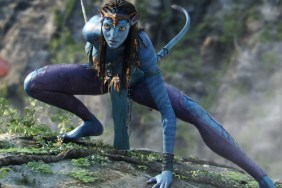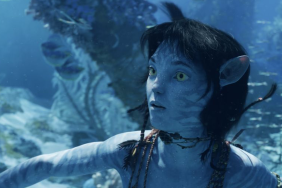Warning: There are some spoilers ahead for Avatar: The Way of Water!
It may seem an odd thing to say about an even-more-expensive sequel to an already massively budgeted original, but Avatar: The Way of Water actually comes across as a more intimate, personal story than the first. That’s because while Avatar‘s central conflict was a clash of civilizations — Earth’s heavy-mining RDA forces and their former-marine security forces versus the Na’vi natives of planet Pandora — the new one is essentially just a one-on-one return grudge match between Jake Sully (Sam Worthington) and Miles Quaritch (Stephen Lang). Jake voluntarily gave up his human body to permanently inhabit his lab-created Na’vi body last movie. Quaritch, killed in battle by Neytiri (Zoe Saldana), now finds himself in a similar blue form, with his back-up memories effectively downloaded into a newly generated Na’vi avatar.
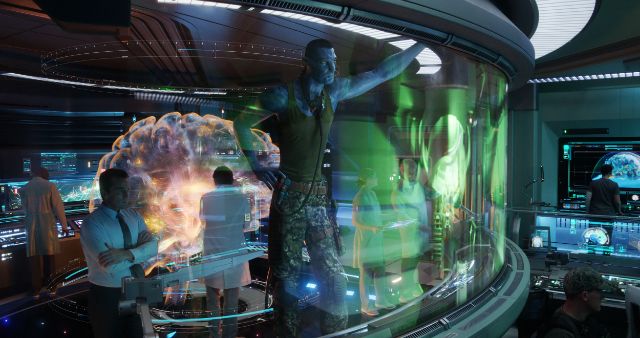
In theory, Quaritch version 2.0, along with a small squad of similar troops, is on Pandora to keep Sully from attacking all further human incursions. Once Quaritch realizes the circumstances under which he originally died, however, it becomes a more personal manhunt. Sully can stand down, or even run away, but his reconstituted foe will make like Inspector Javert (or perhaps more to the point, the Terminator) and not stop until one of them is dead. Whatever that means, in a universe where minds can apparently get re-downloaded anyway.
RELATED: James Cameron and Jon Landau Share Plans For Avatar 4 and 5
And run Sully does, once he realizes the potential danger to his mostly teenage children. Placing immediate family over tribe, he resigns from the forest-dwelling Omaticaya, and seeks out the Na’vi version of witness protection for himself, Neytiri, and the kids among vast stretches of small, tropical islands. The RDA’s happy enough to have him out of the way, but Quaritch isn’t the type of guy to settle for that.
That’s just the first hour of the three hour-plus movie.
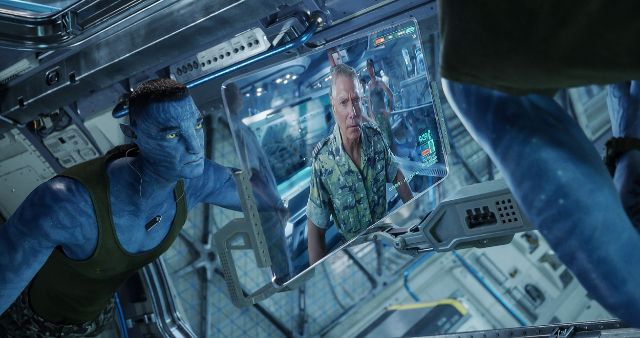
Part of the original Avatar‘s brilliance was the way it gradually escalated and hand-held the audience through the transition from recognizable human civilization to full-on wild dragon riding in a bioluminescent jungle. Through the newcomer Sully’s eyes, the audience became acclimatized to a new ecosystem and culture, falling for it — and Neytiri — along with the protagonist. The Way of Water can’t really duplicate that, though it can correctly assume some familiarity with the situation this time. At first, it’s just more of things you’ve seen before. Then, once the Sullys flee to the islands, damned if writer-director James Cameron doesn’t pull off a version of the same trick again. Once more introducing a new-to-Jake Sully corner of the universe, he gradually immerses us in a new culture of water.
RELATED: Producer Jon Landau Shares an Update on Avatar 4
Once we’re four sequels deep, this trick might get old. At some point, Jake may run out of entirely different parts of the ecosystem to get adjusted in. For now, however, it’s still a good one, especially since “underwater” is director Cameron’s favorite biome. Anyone who happened to catch his 3D documentary Aliens of the Deep way back when will now recognize it as the real-world forerunner of The Way of Water. From the custom miniature submarines to the way schools of sea creatures move, it’s the fictional culmination of a lifetime in his diving hobby. Shown in some theaters in high-frame rate and 3D, this movie, like Ang Lee’s Gemini Man (particularly that movie’s water-bound fights) makes the screen feel like an invisible window into an infinite aquarium.
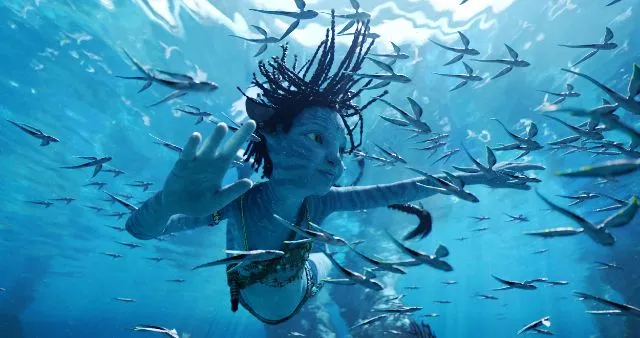
The new Na’vi, the Metkayina clan, borrow more heavily from Pacific Islander cultures, and thus movies like Moana and Whale Rider as well, with which it shares key cast members like Jemaine Clement and Cliff Curtis. Physically adapted to the ocean, the Metkayina feature broader, eel-like tails and oversized forearms that could be a subtle nod to Popeye the Sailor Man. More noticeably, they sport Maori-style facial tattoos, which they also apply to Tulkuns, Pandora’s version of whales. It’s okay, though — they have the consent of said Tulkuns, with whom they communicate via a mixture of sign language, whale song, telepathy/empathy, and of course those organic USB ports in their ponytails.
RELATED: Avatar: The Way of Water Featurette Brings Fans Back to Pandora
If your favorite Star Trek movie was part IV, The Voyage Home, you’re in luck, in other words, because here comes another big sci-fi sequel about saving the whales. It feels downright nostalgic to have the ecological message boiled down to that after so many climate change movies, and it also allows for easier heroes and villains. Especially on a planet where everyone has verifiable scientific proof that the whales are more intelligent beings than the humanoids. But while Leonard Nimoy pointedly avoided guns and outright villains in his whale sequel, Cameron has fewer qualms. Stuff still gets shot, blown up and capsized real good. Also, Quaritch remains a huge jerk, though he’s given more dimension and more complex loyalties.
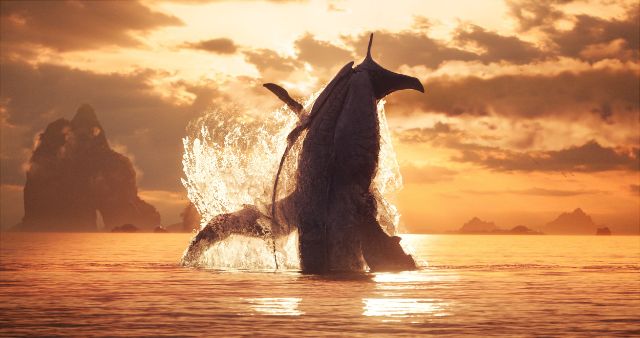
With a lot more characters this time around, not everyone gets more to do. Neytiri in particular feels diminished, after being the best character in the original. Now that she’s a mother, her main modes seem to be either screaming or crying. With Jake acting more restrained, he makes a better fit for Worthington’s generally low-key demeanor, though his narration makes less sense now that it’s all interior monologue rather than diagetic, in-story video journaling. Norm (Joel David Moore) and Max (Dileep Rao) show up briefly to remind us they exist, as does Giovanni Ribisi’s Parker via prerecorded message.
RELATED: Avatar’s Stephen Lang Discusses Quaritch’s Obvious and Subtle Changes
For all the returning actors, and additional star power (Kate Winslet!), though, Cameron’s narrative focus here is on handing things off to the next generation. The Way of Water is really about the kids. The main focus are the Sullys, played by Jamie Flatters, Britain Dalton, Trinity Jo-Li Bliss, and, uh, Sigourney Weaver (it’s complicated). Then there’s Bailey Bass as Reya, the Metkayina chief’s daughter, and Filip Geljo and Duane Evans Jr. as young hunters suspicious of the new kids.
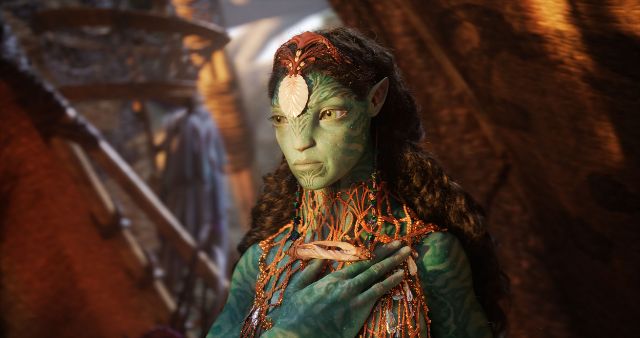
Finally, there’s Jack Champion as Spider, a human kid born too young for cryosleep back to Earth, and a more accurate Dances With Wolves/Tarzan-esque example of what a non-avatar white person gone native looks like on Pandora. Cameron’s track record for casting new faces remains solid; like Carrie Henn in Aliens or Eddie Furlong in T2, these youngsters hold your attention and their own against bigger stars. That’s with the added challenge of free diving. They not only had to hold their breaths while acting, but in some scenes must convincingly pretend they’re getting oxygen through the skin by other means, during longer takes. Most of what appears onscreen may seem CG, but the actors and the water they’re immersed in aren’t.
RELATED: Avatar: The Way of Water Featurette Focuses on Upping the Ante
It therefore comes as no surprise when The Way of Water evokes The Abyss and Titanic. Outside of Cameron’s familiar touchstones, however, at least five key sequences feel like specific attempts to one-up similar scenes from the Star Wars saga, prequels and sequels included. Plenty of directors have the hubris to attempt such a thing; Cameron can actually pull it off. Fortunately, there’s no annoying cliffhanger at the end, with the story arc at hand getting closure, although a couple of the more intriguing plot points are left dangling for sequels. Someone involved clearly understands the value of fan theories and explainers during the downtime.
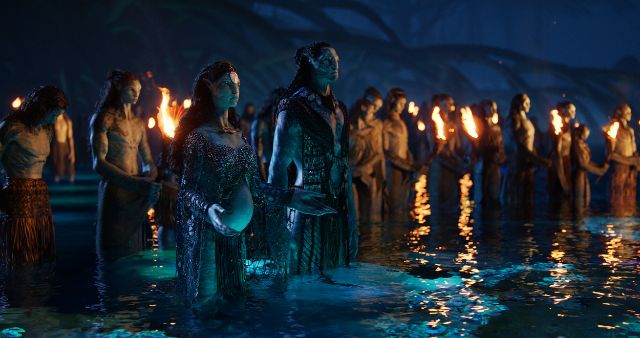
The second trip to Pandora can never feel like quite the game-changer the first one was, however. Unlike Cameron’s other iconic sequels, The Way of Water depends heavily on its predecessor, and doesn’t seem as likely to prevail as a standalone. Then again, people said that about The Empire Strikes Back and Age of Ultron initially too. Sometimes it’s harder to properly consider part 2 until the full arc is visible. For now, we can at least say James Cameron has more than equaled the visual spectacle bar he set for himself, once again creating a world you might feel sad you can’t actually visit. (Good luck approximating free diving, Disney’s Animal Kingdom!)
RELATED: Zoe Saldaña on How James Cameron’s Oceanic Love Inspired Avatar 2
Will the sequel silence the “no cultural footprint” opiners who insist that they cannot remember anything about Avatar besides the 3D, even as they complain about unobtainium sounding silly? It’s anyone’s guess, but if these movies were just empty spectacle, they’d go the way of truly forgettable over-budgeted sci-fi actioners like Moonfall and Geostorm. With its mix of religious allegory, Gaia theory, intergalactic travelogue, faux-indigenous mythology, partial wish fulfillment, and fundamental optimism, the Avatar franchise hits on more levels than may seem consciously apparent. But even if it’s “just” a bunch of 3D action, the fact that it’s pretty much the best 3D action ever made has to count for something.
Avatar: The Way of Water open in theaters Friday
Grade: 5/5
Recommended Reading: James Cameron’s Avatar: Tsu’tey’s Path
We are also a participant in the Amazon Services LLC Associates Program. This affiliate advertising program also provides a means to earn fees by linking to Amazon.com and affiliated sites. Additionally. However.







